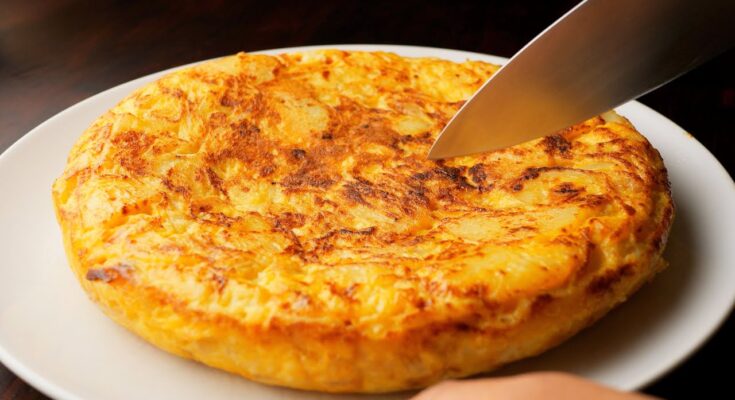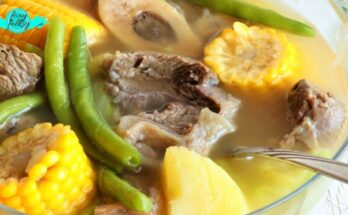Spanish Omelette Recipe: A Spanish omelette—known as Tortilla Española or Tortilla de Patatas—is more than just eggs and potatoes. It’s a staple of Spanish cuisine, a national treasure, and a go-to dish for everything from family dinners to elegant tapas nights. Imagine biting into a warm, golden slice of layered potatoes gently cooked in olive oil, wrapped in a soft, eggy embrace. It’s simple, humble, yet packed with flavor that speaks to the soul of Spain’s culinary heritage.
Spanish omelettes differ from your typical breakfast omelet. They’re thicker, more substantial, and usually served at room temperature. Unlike the French-style omelet, which is quick and runny, the Spanish version is slow-cooked and hearty—perfect for brunch, a light dinner, or as part of a party platter.
It’s a dish that captures attention with its simplicity, versatility, and rich cultural roots. Whether you serve it as a snack, a side, or a main dish, the Spanish omelette never fails to impress.
History and Origin of Spanish Omelette (Tortilla Española)
Let’s take a quick journey back in time. The origins of the Spanish omelette trace back to the 18th century. Legend has it that General Tomás de Zumalacárregui, during the Carlist Wars, created this dish as a quick and nutritious solution to feed his troops. With just eggs, potatoes, and a bit of olive oil, a filling meal was born that later became a classic.
Over time, this peasant-friendly dish climbed its way into every Spanish household. Today, you’ll find it served in tapas bars, at family picnics, or even packed into school lunches. While the ingredients remain largely the same, each region—and even each cook—adds their own twist, making the Spanish omelette a truly personal creation.
This historical evolution shows how food can unite a nation and adapt over centuries while still staying true to its roots.
Why This Recipe is So Popular Around the World
Why does the Spanish omelette enjoy such international fame? For starters, it’s incredibly affordable. With just a few pantry staples, you can whip up something that feels gourmet. It’s also gluten-free, naturally vegetarian, and easy to customize, which appeals to a wide range of diets and lifestyles.
More importantly, the Spanish omelette is a showcase of texture and flavor. Crispy, tender potatoes contrasted by creamy eggs—it’s comfort food that’s elegant enough for entertaining. Its beauty lies in how it balances rustic charm with culinary finesse.
Plus, it holds up well. You can make it ahead of time, serve it warm or cold, and take it anywhere—picnics, potlucks, lunchboxes, or even breakfast sandwiches.
Whether you’re a home cook or a foodie explorer, the Spanish omelette is a must-have in your recipe arsenal.
Ingredients You’ll Need
Core Ingredients for an Authentic Spanish Omelette
To get started with a truly authentic Spanish omelette, you only need a handful of ingredients. But don’t be fooled—each one plays a crucial role in bringing out that classic taste and texture.
Here’s what you’ll need:
- 6 medium potatoes (Yukon Gold or Russets work best)
- 1 large onion (yellow or white)
- 6 large eggs
- 1 ½ cups olive oil (for frying)
- Salt to taste
Let’s break that down a bit.
- Potatoes are the backbone of the dish. When sliced thin and slowly fried, they turn tender and flavorful. The goal is not to crisp them like French fries but to make them soft, almost like confit.
- Onions bring sweetness. While purists sometimes debate the inclusion of onions (con cebolla vs. sin cebolla), most agree that a lightly caramelized onion adds depth and a mellow savoriness that elevates the entire dish.
- Eggs bind everything together. They should be fresh and room temperature for the best results.
- Olive oil isn’t just a cooking medium—it’s a flavor component. Choose a good-quality extra virgin olive oil, because you’ll taste it in every bite.
- Salt is the only seasoning you’ll need, and it should be used with care to bring out the natural flavors of the ingredients.
Optional Add-Ins for a Twist on Tradition
Once you’ve mastered the classic version, you might want to get creative. Here are some popular (and delicious) add-ins:
- Red bell peppers – for color and sweetness
- Chorizo – adds a smoky, meaty kick
- Cheese – like Manchego or sharp cheddar for a gooey twist
- Spinach or kale – for a healthier, green version
- Garlic – minced and sautéed for added aroma
- Herbs – parsley, thyme, or rosemary for a fresh finish
These additions aren’t “traditional” in the strictest sense, but they’re widely accepted and adored in modern kitchens.
Ingredient Substitutions for Dietary Needs
Cooking for a specific diet? No problem. The Spanish omelette can be easily adapted.
- Vegan version – Use chickpea flour and water (also known as “vegan egg”) to replace eggs.
- Low-fat version – Reduce the olive oil and cook the potatoes in the oven or microwave instead.
- Low-carb version – Replace potatoes with zucchini or cauliflower slices.
- Allium-free – Skip the onions if you’re sensitive to them; the flavor will be simpler but still enjoyable.
Whatever your dietary need, there’s a way to tweak the recipe without losing its essence.
Tools and Equipment Needed
Kitchen Essentials for Cooking the Perfect Omelette
Before diving into the recipe, let’s make sure your kitchen is ready. Here are the essential tools you’ll need:
- Cutting board and sharp knife – for prepping your potatoes and onions
- Peeler – to get those potato skins off easily
- Large bowl – for beating eggs and mixing ingredients
- Slotted spoon or spider strainer – helps lift the potatoes from oil without excess grease
- 12-inch non-stick or cast-iron skillet – critical for cooking and flipping
- Plate or flat lid – used to flip the omelette mid-cooking
- Spatula – to help shape the edges and loosen the omelette
Having the right tools can make all the difference between a cracked, stuck disaster and a flawless, golden tortilla.
Choosing the Right Pan
Let’s talk pans—because it matters more than you think.
The ideal pan for a Spanish omelette is either:
- Non-stick skillet – easy for beginners, less worry about sticking
- Well-seasoned cast-iron pan – holds heat well and browns beautifully
A 12-inch pan makes a medium-thick omelette using the ingredient quantities above. If you prefer a thicker tortilla, go for a smaller pan. Just adjust cooking times accordingly.
Make sure the pan has a slightly sloped edge—this helps you slide the omelette out and flip it more easily.
Step-by-Step Guide to Making Spanish Omelette
Step 1 – Prepping the Potatoes and Onions
Start by peeling about four medium-sized potatoes and slicing them thinly — think coin-thin, not paper-thin. Next, peel and finely slice one large onion. The key is even cuts so everything cooks uniformly. Rinse the potatoes briefly to remove excess starch, then pat them dry with a clean towel. Spanish omelette (or tortilla española) is all about simplicity and balance, so the prep work sets the tone for the whole dish.
Step 2 – Cooking the Vegetables to Perfection
In a large non-stick skillet, heat plenty of olive oil over medium heat. Add the sliced potatoes first and cook gently for about 10–12 minutes, stirring occasionally. Then, toss in the onions and continue cooking until both are soft but not browned — golden, tender, and slightly translucent. Drain them using a slotted spoon, reserving a little of that fragrant olive oil for later.
Step 3 – Beating the Eggs and Mixing Ingredients
Crack six large eggs into a mixing bowl and beat them lightly with a pinch of salt. Add the cooked potatoes and onions into the eggs, stirring gently to combine. Let the mixture rest for about 5–10 minutes. This allows the eggs to soak into the potatoes, creating that signature creamy texture once cooked.
Step 4 – Cooking the Omelette on the Stove
Heat a tablespoon of the reserved olive oil in the skillet over medium-low heat. Pour in the egg mixture and spread it evenly. Cook slowly for about 5–7 minutes, gently shaking the pan occasionally to prevent sticking. The edges should set while the center remains slightly runny. Patience here is key — low and slow cooking gives you a tender, fluffy omelette rather than a dry one.
Step 5 – The Art of Flipping the Omelette
Now comes the classic Spanish test of skill. Place a large flat plate over the pan, hold both tightly, and flip the omelette onto the plate. Slide it back into the pan to cook the other side for another 3–5 minutes until golden and fully set. Let it rest for a few minutes before slicing. Serve warm or at room temperature — it’s delicious either way, especially with a side of crusty bread or a simple salad.
Tips for a Perfect Spanish Omelette
Common Mistakes to Avoid
Even though a Spanish omelette uses simple ingredients, it’s surprisingly easy to mess up if you’re not careful. Here are the most common mistakes that can ruin your tortilla—and how to avoid them:
- Overcooking the eggs – The biggest crime against a Spanish omelette is dry, rubbery eggs. Cook on low heat and never rush it.
- Undercooked potatoes – If your potato slices are too thick or not cooked long enough in the oil, they’ll be tough and unpleasant. Make sure they’re tender before mixing with the eggs.
- Flipping too soon – If the bottom hasn’t set, flipping can lead to a broken mess. Wait until the edges are firm and the middle has just started to set.
- Using too little oil – Don’t skimp. The oil is essential for texture and flavor. Just be sure to drain it well after cooking the potatoes.
- Wrong pan choice – If your pan isn’t non-stick or seasoned properly, you risk the omelette sticking and breaking during the flip.
Avoiding these pitfalls can be the difference between a so-so tortilla and a flawless one that has everyone asking for seconds.
Texture, Thickness, and Timing Tips
Want to go from “good” to “exceptional”? Here’s how you can perfect your technique:
- Texture: The ideal Spanish omelette has a slightly creamy interior and a gently crisp exterior. You get this by slow-cooking the eggs and not over-stirring the mixture in the pan.
- Thickness: Use a smaller pan for a thicker tortilla. Just remember to adjust your cooking time—thicker omelettes need longer to cook through.
- Timing: Give the egg-potato-onion mixture a few minutes to sit before pouring it into the pan. This helps everything bind together more naturally.
If you’re aiming for a gooey, custard-like center (the jugosa style loved by many Spaniards), take it off the heat just before it’s fully set. If you prefer it cooked all the way through, let it go a few minutes longer, just be careful not to dry it out.
Serving Suggestions
What to Serve with Spanish Omelette
The Spanish omelette is versatile and pairs well with a variety of side dishes depending on the occasion. Here are a few ideas:
- Crusty bread or toast – The classic pairing, perfect for soaking up the eggy goodness.
- Tomato salad – A simple mix of tomatoes, olive oil, and salt provides a refreshing contrast.
- Garlic aioli – Drizzle some homemade or store-bought aioli over the top for a rich, garlicky finish.
- Green salad – Light and crisp greens dressed in lemon vinaigrette balance the richness of the tortilla.
- Pickled vegetables or olives – Their tanginess cuts through the heaviness and adds Mediterranean flair.
Whether served as a tapas appetizer or the main event at brunch, the tortilla adapts beautifully to your table spread.
Best Drinks to Pair with It
The flavors of a Spanish omelette pair best with light, fresh beverages that don’t overpower the dish. Here’s what we recommend:
- Spanish red wine – A young Rioja or Garnacha brings mild acidity and fruitiness to balance the omelette’s richness.
- Cava – This Spanish sparkling wine adds elegance and light bubbles to cleanse your palate.
- Tinto de verano – A refreshing Spanish cocktail made with red wine and lemon soda, perfect for hot days.
- Fresh orange juice – For a brunch setting, nothing beats the citrusy brightness of freshly squeezed juice.
- Sparkling water with lemon – Clean and refreshing for a simple, non-alcoholic option.
Your tortilla deserves a worthy partner—something that elevates but doesn’t distract.
Storing and Reheating Spanish Omelette
How to Store Leftovers Safely
Leftovers? Lucky you! Spanish omelette keeps really well and some say it tastes even better the next day. Here’s how to store it right:
- Let it cool completely before wrapping it.
- Wrap in cling film or foil tightly, or place it in an airtight container.
- Store in the refrigerator for up to 3–4 days.
For best results, cut it into portions before storing. That way, you can grab a slice whenever you want without disturbing the whole tortilla.
Best Methods for Reheating Without Losing Texture
Reheating can be tricky—do it wrong, and you’ll end up with dry eggs or soggy potatoes. Here are the best ways to do it right:
- Stovetop: Place a slice in a non-stick pan over low heat. Cover with a lid and warm for a few minutes on each side. This method retains texture the best.
- Oven: Wrap slices in foil and heat at 300°F (150°C) for about 10–15 minutes.
- Microwave (least recommended): Use only if you’re in a rush. Microwave a slice on medium power in 20-second bursts to avoid overcooking.
Whatever method you choose, be gentle—this is a dish that rewards patience.
Variations of Spanish Omelette
Vegetarian Version
The classic Spanish omelette is naturally vegetarian, but if you’re looking to jazz it up while keeping it meat-free, there are loads of delicious options. Try adding seasonal vegetables like:
- Roasted red peppers – for smoky sweetness
- Zucchini or courgette – thinly sliced and sautéed
- Mushrooms – earthy and savory, especially cremini or button mushrooms
- Sun-dried tomatoes – for a tangy, umami kick
- Spinach or kale – chopped and wilted into the eggs
These additions create a more colorful and nutrient-dense omelette without straying too far from the traditional flavor profile. Just make sure to cook the veggies beforehand to remove excess moisture and prevent a soggy tortilla.
You can also sprinkle in fresh herbs like parsley, basil, or chives to brighten the dish. A vegetarian Spanish omelette is perfect for brunch, Meatless Mondays, or when you just want a lighter option that still fills you up.
Spanish Omelette with Cheese and Ham
If you want something heartier, adding cheese and ham is a no-brainer. This version is particularly popular for brunches and comfort-food lovers.
Recommended cheeses include:
- Manchego (classic Spanish cheese)
- Cheddar (sharp and melty)
- Gruyère (for a nutty twist)
- Mozzarella (if you love stretch)
For ham, you can go with:
- Jamón Serrano or Iberico for authentic Spanish flavor
- Prosciutto for an Italian spin
- Cooked ham cubes or pancetta for a smoky edge
To make it, layer in the cheese and ham after adding the eggs to the pan. Let it melt and settle into the tortilla as it cooks. The result? A gooey, savory delight that combines traditional Spanish elements with a rich, satisfying filling.
Gluten-Free and Vegan Options
Need to accommodate special diets? No worries—there are still ways to enjoy a Spanish omelette.
For Gluten-Free diets:
- The standard recipe is already gluten-free, just be cautious about any add-ins (e.g., store-bought ham or cheese with added starches).
- Serve with gluten-free bread or salad.
For Vegan diets:
Replace eggs with a chickpea flour batter:
- 1 cup chickpea flour
- 1 cup water
- ½ tsp turmeric (for color)
- Salt and pepper to taste
Mix the batter well and use it as an egg substitute. Cook the potatoes and onions as usual, then mix them into the chickpea batter. Fry it up the same way. It won’t be quite the same as the egg-based version, but it’s hearty, flavorful, and deeply satisfying.
Nutritional Breakdown
Calories and Macronutrients
Here’s a general idea of the nutritional profile per serving (based on a traditional 6-egg, 6-potato, 1-onion recipe that serves 4):
| Nutrient | Amount per Serving |
|---|---|
| Calories | ~350–400 kcal |
| Protein | 10–12g |
| Carbohydrates | 30–35g |
| Fat | 20–25g |
| Fiber | 3–4g |
| Sodium | 250–300mg |
This dish is moderately high in calories and fat due to the olive oil, but it’s also rich in protein, fiber, and healthy fats. Use less oil or add more veggies if you want a lighter version.
Health Benefits of Key Ingredients
Let’s talk about what makes the Spanish omelette not just delicious but also nutritionally beneficial:
- Potatoes: Rich in potassium, vitamin C, and fiber. They provide complex carbs that offer sustained energy.
- Eggs: Packed with protein, choline, and healthy fats. They help build muscle, support brain function, and keep you full.
- Onions: Loaded with antioxidants and natural anti-inflammatory compounds.
- Olive Oil: A heart-healthy fat known to reduce inflammation and support cardiovascular health.
With these ingredients combined, you’re getting a meal that’s hearty, satisfying, and packed with essential nutrients.
FAQs about Spanish Omelette Recipe
Q1: Can I make Spanish omelette ahead of time?
Absolutely. It keeps well for up to 3–4 days in the fridge. It’s great served cold or reheated for a quick meal.
Q2: Is it okay to freeze Spanish omelette?
Yes, you can freeze it, though the texture may change slightly. Wrap tightly in plastic wrap and foil. Thaw in the fridge overnight and reheat in a skillet.
Q3: Can I skip the onions?
Yes, but you’ll lose a bit of sweetness and depth. The “with or without onion” debate is huge in Spain, so it’s all personal preference.
Q4: What’s the difference between tortilla Española and tortilla francesa?
Tortilla Española (Spanish omelette) is made with eggs, potatoes, and often onions. Tortilla Francesa is just eggs—like a classic French-style omelet.
Q5: Can I bake the Spanish omelette instead of frying?
Yes, you can finish it in the oven or even bake the entire dish in an ovenproof pan. It’s easier to control the cooking and avoids flipping.
Conclusion
The Spanish omelette—simple, soulful, and endlessly versatile—is a dish that belongs in every kitchen. Whether you’re keeping it classic with just eggs and potatoes, loading it with veggies, or adding melty cheese and savory ham, the tortilla Española never fails to deliver. It’s comfort food at its finest—humble ingredients elevated by care and tradition.
This recipe is more than a meal; it’s a slice of Spanish culture you can bring to your own table. Whether you’re preparing it for a quiet weeknight dinner, a fancy brunch, or as tapas at your next party, one thing is certain: you’ll make it again and again.
So grab your eggs, peel those potatoes, and let’s cook up a little piece of Spain. You’ve got all the steps, tips, and tricks to make it perfect—now it’s your turn to bring this classic to life.



